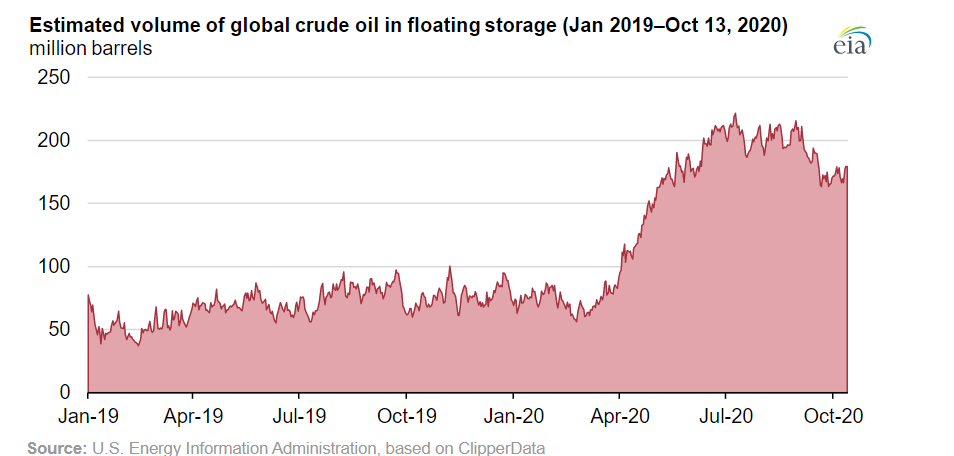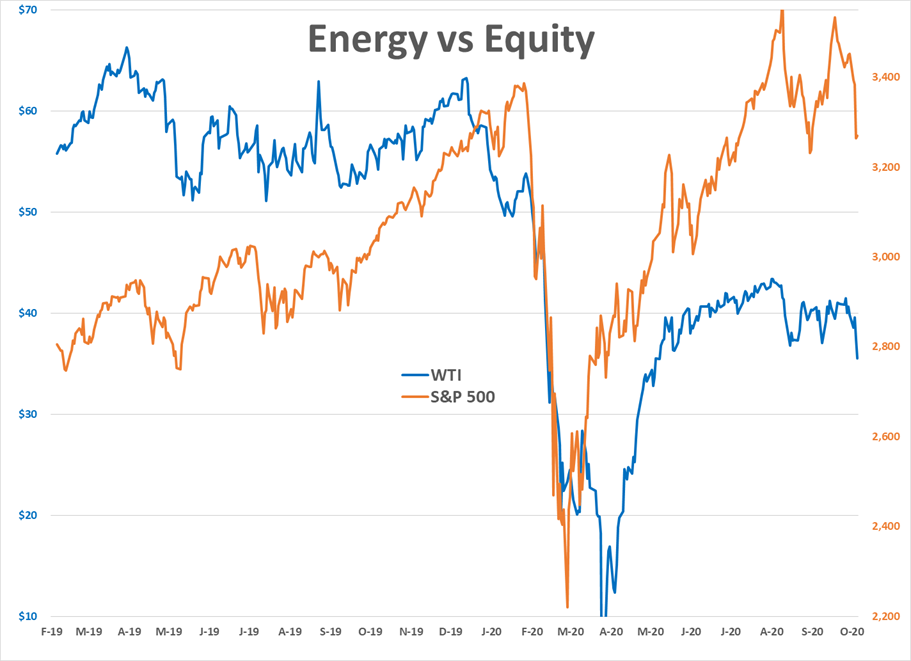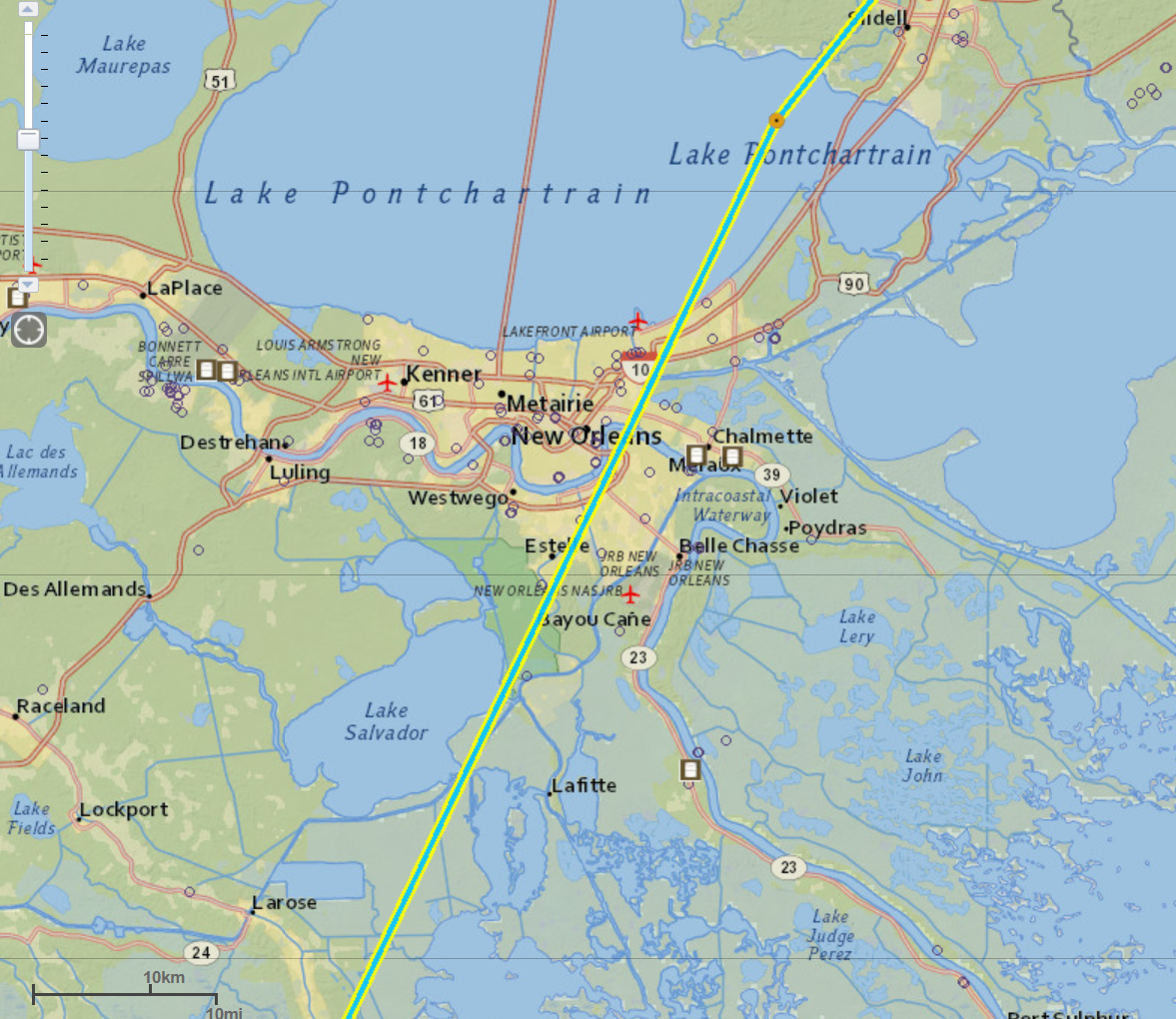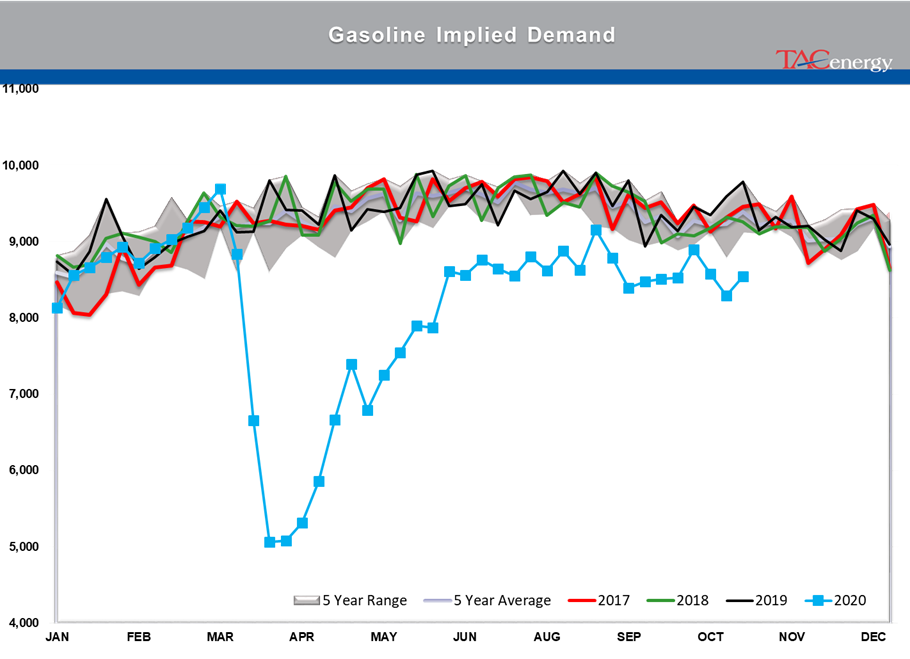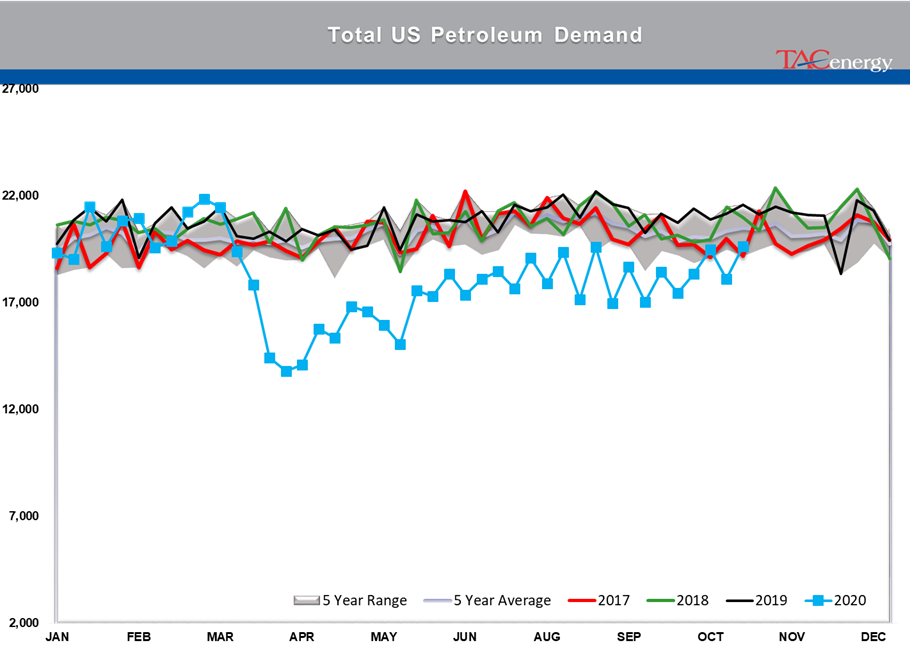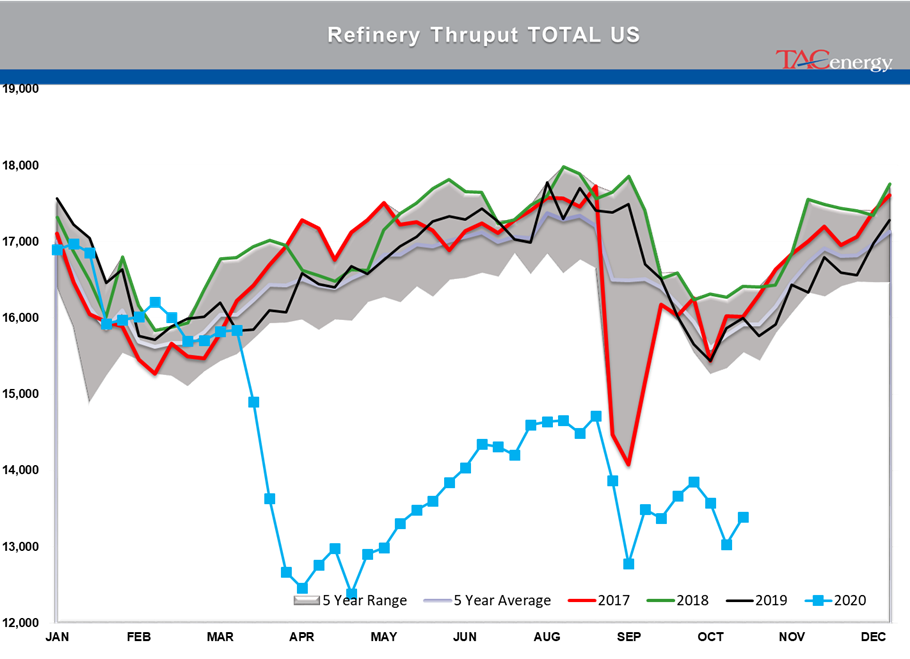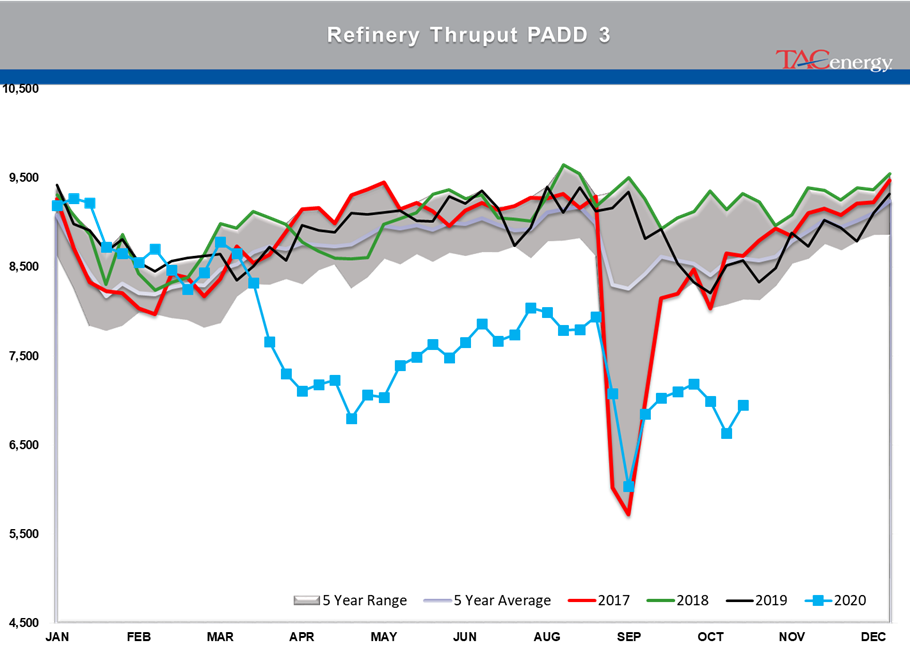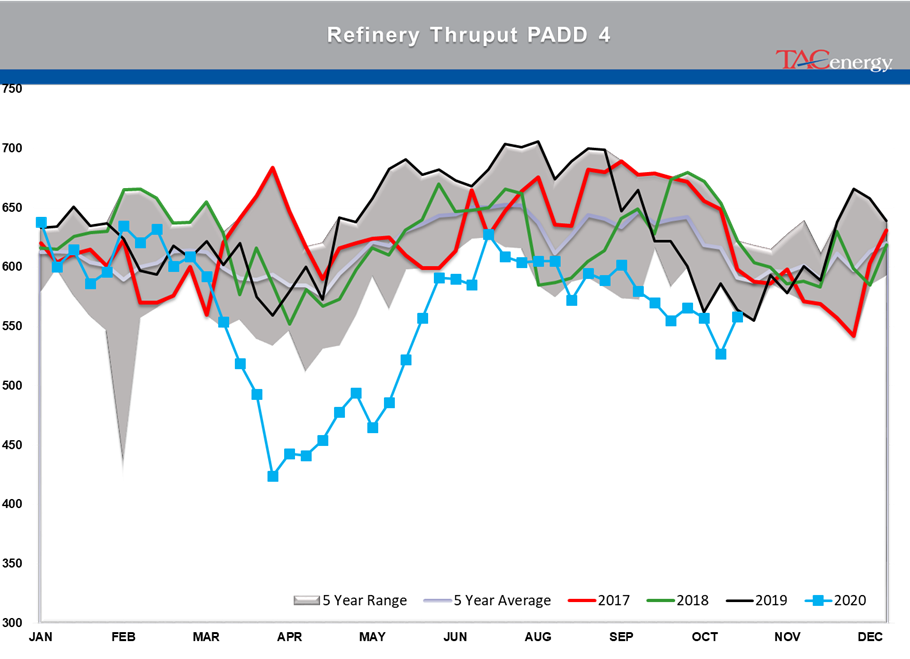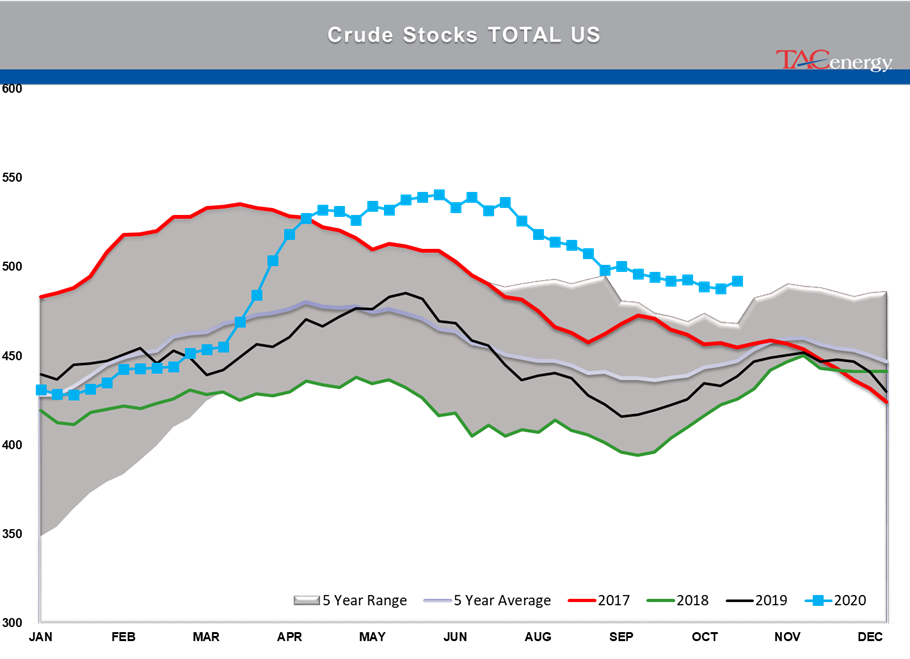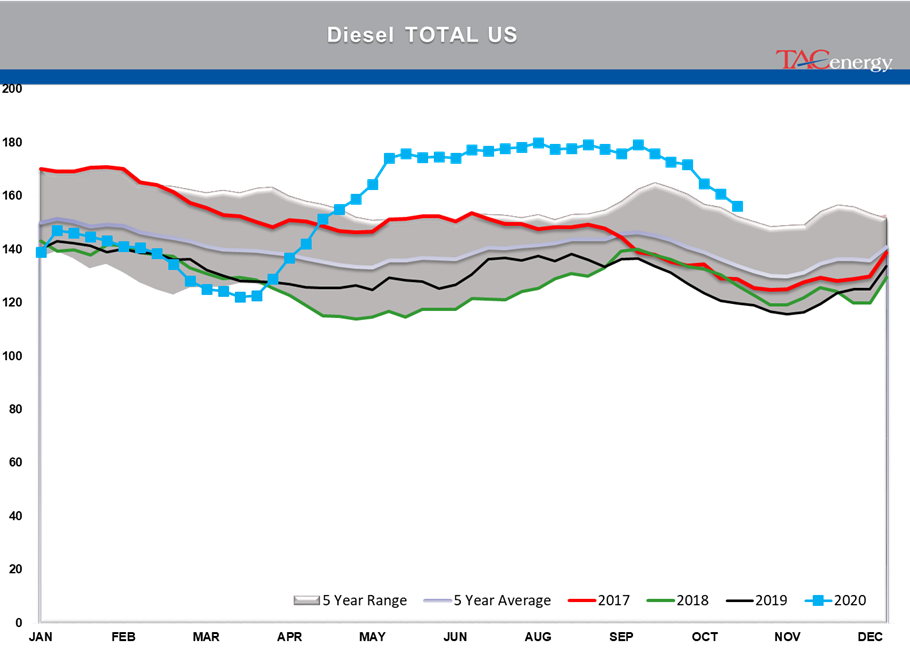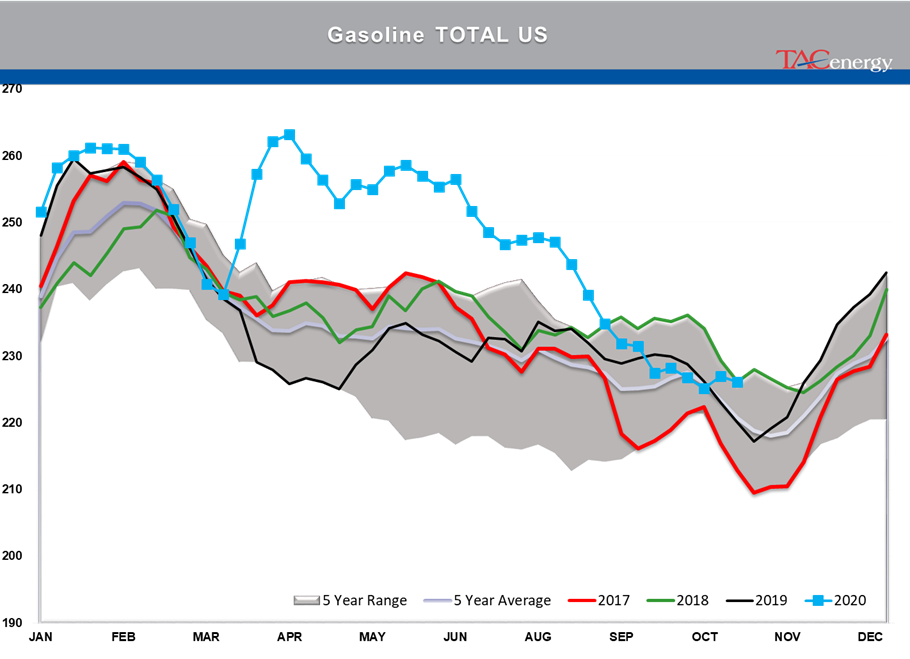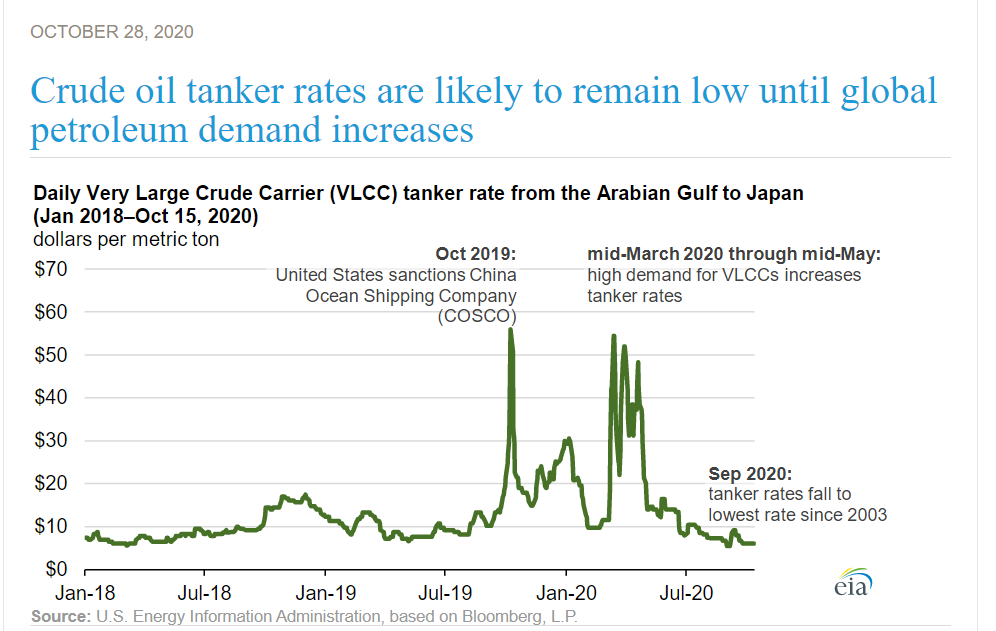Technical Trapdoor Opens

The technical trapdoor has opened and energy prices fell right through with refined products dropping more than a dime since Tuesday’s close. Fear continues to be in the driver seat across multiple asset classes as U.S. equities had their biggest one-day selloff since June, while energy futures were reaching multi-month lows.
Yesterday’s DOE report was actually more bullish than the API report that got credit for an early wave of selling, with gasoline and diesel stocks declining and demand increasing across the board, but it did little to slow the downward momentum. Now that support is broken on the charts, and traders appearing to fixate more on where demand is headed instead of where it is, it looks like the next stop is $34 for WTI and $.96 for RBOB unless the bargain hunters start stepping in soon. ULSD prices still have not broken their September lows, but if they do break $1.06, it looks like they’ll make a push towards the $1 mark as well.
How 2020 is this? A hurricane made a direct hit on one of the country’s largest refinery clusters Wednesday, and that wasn’t even the biggest refining news of the day.
PBF announced it was halting fuel production at its Paulsboro, NJ facility due to the ongoing demand destruction and weak economic outlook for refining in the region. The facility may reopen in a limited capacity when demand recovers, but will be focused on providing feedstocks to PBF’s other east coast refinery in Delaware City. 18 months ago, the east coast (PADD 1) had 1.2 million barrels/day of refining capacity, when PES shut down that dropped to 889,000 barrels/day, and with Paulsboro offline will fall to roughly 723,000 barrels/day. That 40% decline in less than two years is certainly a big deal, but should not have an immediate impact on supply as actual run rates in the region are currently below 600,000 barrels/day. There is capacity on pipelines from the Gulf Coast and from waterborne vessels to cover this drop in production – particularly at current demand levels – but that loss of production will create the potential for supply bottlenecks, particularly in the Philadelphia market when summer demand is at its peak and VOC restrictions on RBOB limit supply.
Zeta made landfall as a strong Category 2 hurricane Wednesday night, with winds around 110 miles an hour (just 1 mph below Category 3 status). The storm passed within about five miles of the Valero/Meraux and PBF/Chalmette refineries as it moved through New Orleans. Earlier reports suggested that the NOLA-area refineries planned to operate through the storm, but now it appears that power outages have taken several of them offline temporarily while damage assessments are underway.
Make no mistake, in any other year, having five tropical systems hitting refining country and knocking multiple refineries offline in one season would be cause for sharply higher prices, and potential shortages throughout the region. This year, Gulf Coast cash markets have barely flinched and futures are tumbling due to the lack of demand that means there’s plenty of capacity to offset the storm-induced outages.
An EIA report Wednesday showed how tanker rates that spiked into the spring due to the super-contango forward curve have now reached their lowest levels in nearly two decades and are expected to remain at low levels until global demand recovers.
Click here to download a PDF of today's TACenergy Market Talk.
Latest Posts
Gasoline Futures Are Leading The Way Lower This Morning
The Sell-Off Continues In Energy Markets, RBOB Gasoline Futures Are Now Down Nearly 13 Cents In The Past Two Days
Week 15 - US DOE Inventory Recap
Prices To Lease Space On Colonial’s Main Gasoline Line Continue To Rally This Week
Social Media
News & Views
View All
Gasoline Futures Are Leading The Way Lower This Morning
It was a volatile night for markets around the world as Israel reportedly launched a direct strike against Iran. Many global markets, from equities to currencies to commodities saw big swings as traders initially braced for the worst, then reversed course rapidly once Iran indicated that it was not planning to retaliate. Refined products spiked following the initial reports, with ULSD futures up 11 cents and RBOB up 7 at their highest, only to reverse to losses this morning. Equities saw similar moves in reverse overnight as a flight to safety trade soon gave way to a sigh of relief recovery.
Gasoline futures are leading the way lower this morning, adding to the argument that we may have seen the spring peak in prices a week ago, unless some actual disruption pops up in the coming weeks. The longer term up-trend is still intact and sets a near-term target to the downside roughly 9 cents below current values. ULSD meanwhile is just a nickel away from setting new lows for the year, which would open up a technical trap door for prices to slide another 30 cents as we move towards summer.
A Reuters report this morning suggests that the EPA is ready to announce another temporary waiver of smog-prevention rules that will allow E15 sales this summer as political winds continue to prove stronger than any legitimate environmental agenda. RIN prices had stabilized around 45 cents/RIN for D4 and D6 credits this week and are already trading a penny lower following this report.
Delek’s Big Spring refinery reported maintenance on an FCC unit that would require 3 days of work. That facility, along with several others across TX, have had numerous issues ever since the deep freeze events in 2021 and 2024 did widespread damage. Meanwhile, overnight storms across the Midwest caused at least one terminal to be knocked offline in the St. Louis area, but so far no refinery upsets have been reported.
Meanwhile, in Russia: Refiners are apparently installing anti-drone nets to protect their facilities since apparently their sling shots stopped working.
Click here to download a PDF of today's TACenergy Market Talk.

The Sell-Off Continues In Energy Markets, RBOB Gasoline Futures Are Now Down Nearly 13 Cents In The Past Two Days
The sell-off continues in energy markets. RBOB gasoline futures are now down nearly 13 cents in the past two days, and have fallen 16 cents from a week ago, leading to questions about whether or not we’ve seen the seasonal peak in gasoline prices. ULSD futures are also coming under heavy selling pressure, dropping 15 cents so far this week and are trading at their lowest level since January 3rd.
The drop on the weekly chart certainly takes away the upside momentum for gasoline that still favored a run at the $3 mark just a few days ago, but the longer term up-trend that helped propel a 90-cent increase since mid-December is still intact as long as prices stay above the $2.60 mark for the next week. If diesel prices break below $2.50 there’s a strong possibility that we see another 30 cent price drop in the next couple of weeks.
An unwind of long positions after Iran’s attack on Israel was swatted out of the sky without further escalation (so far anyway) and reports that Russia is resuming refinery runs, both seeming to be contributing factors to the sharp pullback in prices.
Along with the uncertainty about where the next attacks may or may not occur, and if they will have any meaningful impact on supply, come no shortage of rumors about potential SPR releases or how OPEC might respond to the crisis. The only thing that’s certain at this point, is that there’s much more spare capacity for both oil production and refining now than there was 2 years ago, which seems to be helping keep a lid on prices despite so much tension.
In addition, for those that remember the chaos in oil markets 50 years ago sparked by similar events in and around Israel, read this note from the NY Times on why things are different this time around.
The DOE’s weekly status report was largely ignored in the midst of the big sell-off Wednesday, with few noteworthy items in the report.
Diesel demand did see a strong recovery from last week’s throwaway figure that proves the vulnerability of the weekly estimates, particularly the week after a holiday, but that did nothing to slow the sell-off in ULSD futures.
Perhaps the biggest next of the week was that the agency made its seasonal changes to nameplate refining capacity as facilities emerged from their spring maintenance.
PADD 2 saw an increase of 36mb/day, and PADD 3 increased by 72mb/day, both of which set new records for regional capacity. PADD 5 meanwhile continued its slow-motion decline, losing another 30mb/day of capacity as California’s war of attrition against the industry continues. It’s worth noting that given the glacial pace of EIA reporting on the topic, we’re unlikely to see the impact of Rodeo’s conversion in the official numbers until next year.
Speaking of which, if you believe the PADD 5 diesel chart below that suggests the region is running out of the fuel, when in fact there’s an excess in most local markets, you haven’t been paying attention. Gasoline inventories on the West Coast however do appear consistent with reality as less refining output and a lack of resupply options both continue to create headaches for suppliers.

